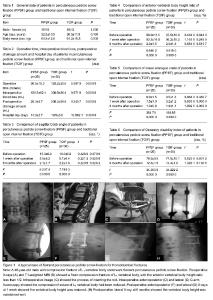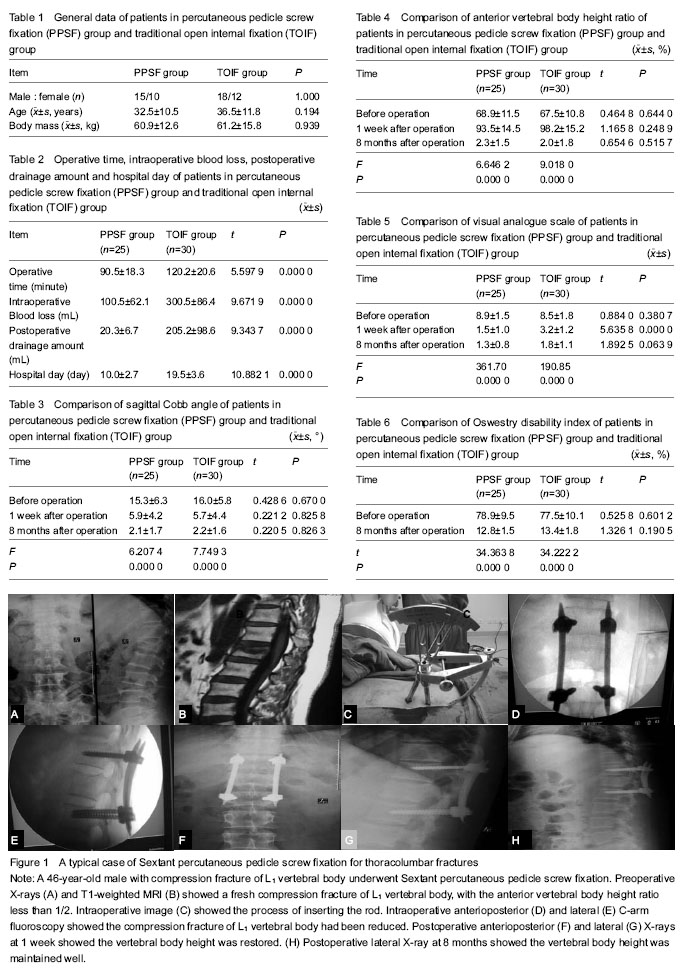Chinese Journal of Tissue Engineering Research ›› 2014, Vol. 18 ›› Issue (35): 5654-5659.doi: 10.3969/j.issn.2095-4344.2014.35.014
Previous Articles Next Articles
Sextant percutaneous pedicle screw fixation for correcting single-segment thoracolumbar fractures
Ming Jiang-hua, Zheng Hui-feng, Zhao Qi, Chen Qing, Wang Gang
- Department of Orthopedics, Renmin Hospital of Wuhan University, Wuhan 430060, Hubei Province, China
-
Revised:2014-07-22Online:2014-08-27Published:2014-08-27 -
About author:Ming Jiang-hua, Ph.D., Chief physician, Master’s supervisor, Department of Orthopedics, Renmin Hospital of Wuhan University, Wuhan 430060, Hubei Province, China Zheng Hui-feng, Studying for doctorate, Department of Orthopedics, Renmin Hospital of Wuhan University, Wuhan 430060, Hubei Province, China Ming Jiang-hua and Zheng Hui-feng contributed equally to this work. -
Supported by:the grants from Renmin Hospital of Wuhan University, No. 2012hx0028
CLC Number:
Cite this article
Ming Jiang-hua, Zheng Hui-feng, Zhao Qi, Chen Qing, Wang Gang. Sextant percutaneous pedicle screw fixation for correcting single-segment thoracolumbar fractures[J]. Chinese Journal of Tissue Engineering Research, 2014, 18(35): 5654-5659.
share this article

Analysis of the number of participants in the two groups All patients in percutaneous pedicle screw fixation group were followed up successfully; in traditional open internal fixation group, besides two patients who were lost, the remaining patients were followed up. The total time of follow-up ranged from 8 to14 months (average, 12.8±1.8 months). There was no statistical difference in age, sex ratio and body mass between two groups (P > 0.05; Table 1). Comparison of outcomes of participants in the two groups The operative time, intraoperative blood loss, postoperative drainage amount and hospital day in the percutaneous pedicle screw fixation group were all less than those in the traditional open internal fixation group, and the differences were statistically significant (P < 0.01; Table 2). There were no significant differences between two groups in terms of sagittal Cobb angle and anterior vertebral body height ratio before and after operation (P > 0.05). No significant difference was found between two groups in correction loss at 8 months after operation (P > 0.05). At 1 week after operation, the sagittal Cobb angle was significantly lower while anterior vertebral body height ratio was significantly higher than those before operation in each group (P < 0.01; Tables 3, 4). Bone healing was obtained in all patients at the last follow-up, without loosening of internal fixators. There were no significant differences between two groups in terms of visual analogue scale and Oswestry disability index before operation and at 8 months after operation (P > 0.05). At 1 week after operation, the visual analogue scale in percutaneous pedicle screw fixation group was significantly less than that in traditional open internal fixation group (P < 0.01). The postoperative visual analogue scale and Oswestry disability index were significantly less than those before operation in each group (P < 0.01). Visual analogue scale at 1 week after operation was significantly higher than that at 8 months after operation in traditional open internal fixation group. More details are shown in Tables 5, 6. Adverse events Delayed healing occurred in two patients due to wound hematocele in traditional open internal fixation group, and I phase healing was obtained in other patients. Typical case A 46-year-old man with L1 vertebra body compression fractures caused by high falling injury, without neurological symptoms and signs, was treated by percutaneous pedicle screw fixation using Sextant system. A 10-month follow-up was obtained, and the vertebral body height retained well during the period of follow-up, without related complications (Figure 1)."

| [1] Boelderl A, Daniaux H, Kathrein A, et al. Danger of damaging the medial branches of the posterior rami of spinal nerves during a dorsomedian approach to the spine. Clin Anat. 2002;15(2):77-81. [2] Agrawal A, Mizuno J, Kato Y, et al. Minimally invasive pedicle screw placement in a case of L4 fracture: case report with review of literature. Asian J Neurosurg. 2010;5(2):64-69. [3] Foley KT, Gupta SK, Justis JR, et al. Percutaneous pedicle screw fixation of the lumbar spine. Neurosurg Focus. 2001; 10(4):E10. [4] Lowery GL, Kulkarni SS. Posterior percutaneous spine instrumentation. Eur Spine J. 2000;9 Suppl 1:S126-130. [5] Magerl FP. Stabilization of the lower thoracic and lumbar spine with external skeletal fixation. Clin Orthop Relat Res. 1984;(189):125-141. [6] Foley KT, Gupta SK. Percutaneous pedicle screw fixation of the lumbar spine: preliminary clinical results. J Neurosurg. 2002;97(1 Suppl):7-12. [7] Wang HW, Li CQ, Zhou Y, et al. The comparision of minimally invasive and traditional open treatment for thoracolumbar fractures using Sextant system. Zhongguo Jizhu Jisui Zazhi. 2010;20(2):112-116. [8] Xiao LY, Guan HG, Cao ZL, et al. Sextant system in the treatment of thoracolumbar fracture. Shiyong Yixue Zazhi. 2012;28(9):1500-1501. [9] Oh HS, Kim JS, Lee SH, et al. Comparison between the accuracy of percutaneous and open pedicle screw fixations in lumbosacral fusion. Spine J. 2013;13(12):1751-1757. [10] Prokop A, Lohlein F, Chmielnicki M, et al. Minimally invasive percutaneous instrumentation for spine fractures. Unfallchirurg. 2009;112(7):621-624, 626-628. [11] Schmidt OI, Strasser S, Kaufmann V, et al. Role of early minimal-invasive spine fixation in acute thoracic and lumbar spine trauma. Indian J Orthop. 2007;41(4):374-380. [12] Wang HW, Li CQ, Zhou Y, et al. Percutaneous pedicle screw fixation through the pedicle of fractured vertebra in the treatment of type A thoracolumbar fractures using Sextant system: an analysis of 38 cases. Chin J Traumatol. 2010;13(3):137-145. [13] Kruger A, Rammler K, Ziring E, et al. Percutaneous minimally invasive instrumentation for traumatic thoracic and lumbar fractures: a prospective analysis. Acta Orthop Belg. 2012;78(3):376-381. [14] Wang HW, Zhou Y, Li CQ, et al. The biomechanicaI and clinical study of the percutaneous pedicle screw fixation in the treatment of thoracolumbar fractures. Zhonghua Guke Zazhi. 2011;31(9):932-937. [15] Kang H, Cai XH, Xu F, et al. Clinical research of minimally invasive surgical management for lumbar spondylolisthesis via quadrant system assisted Sextant-R system. Zhongguo Xiu Fu Chong Jian Wai Ke Za Zhi. 2013;27(4):399-403. [16] Sairyo K, Sakai T, Yasui N. Minimally invasive technique for direct repair of pars interarticularis defects in adults using a percutaneous pedicle screw and hook-rod system. J Neurosurg Spine. 2009;10(5):492-495. [17] Maciejczak A, Barnas P, Dudziak P, et al. Posterior keyhole corpectomy with percutaneous pedicle screw stabilization in the surgical management of lumbar burst fractures. Neurosurgery. 2007;60(4 Suppl 2):232-241; discussion 241-242. [18] Liu T, Li CQ, Zhou Y, et al. The designs and feasibility of clinical applications about a novel percutaneous pedicle screw system. Zhonghua Guke Zazhi. 2010;30(6):594-599. |
| [1] | Song Chengjie, Chang Hengrui, Shi Mingxin, Meng Xianzhong. Research progress in biomechanical stability of lateral lumbar interbody fusion [J]. Chinese Journal of Tissue Engineering Research, 2021, 25(6): 923-928. |
| [2] | Yang Qin, Zhou Honghai, Chen Longhao, Zhong Zhong, Xu Yigao, Huang Zhaozhi. Research status and development trend of pelvic reconstruction techniques: a bibliometric and visual analysis [J]. Chinese Journal of Tissue Engineering Research, 2021, 25(23): 3718-3724. |
| [3] | Zhao Hongshun, A Jiancuo, Wang Deyuan, Xu Zhihua, Gao Shunhong. Factors affecting the height of early intervertebral space after lumbar interbody fusion via lateral approach [J]. Chinese Journal of Tissue Engineering Research, 2021, 25(21): 3332-3336. |
| [4] | Zhang Chongfeng, Li Xianlin, Peng Weibing, Jia Hongsheng, Cai Lei. Treating lumbar disc herniation of blood stasis type with Chinese herbs, acupuncture, moxibustion, and massage: a Bayesian network Meta-analysis [J]. Chinese Journal of Tissue Engineering Research, 2021, 25(17): 2781-2788. |
| [5] |
Zhang Cong, Zhao Yan, Du Xiaoyu, Du Xinrui, Pang Tingjuan, Fu Yining, Zhang Hao, Zhang Buzhou, Li Xiaohe, Wang Lidong.
Biomechanical analysis of the lumbar spine and pelvis in adolescent
idiopathic scoliosis with lumbar major curve |
| [6] | Fang Yi, Zhao Wenzhi, Pan Deyue, Han Xin, Zhang Lu, He Hongtao, Shi Feng, Tian Tingxiao. Acromioclavicular joint dislocation: how to achieve anatomical reduction, sustained stability and micro-motion [J]. Chinese Journal of Tissue Engineering Research, 2020, 24(5): 796-802. |
| [7] | Tuerhongjiang·Abuduresiti, Meng Xiangyu, Maihemuti·Yakufu, Wang Tiantang, Xieraili·Maimaiti, Dai Jifang, Wang Wei. Biomechanical advantages of percutaneous endoscopic lumbar discectomy for lumbar disc herniation [J]. Chinese Journal of Tissue Engineering Research, 2020, 24(36): 5768-5773. |
| [8] | Wang Jing, Xu Shuai, Liu Haiying. Hidden blood loss during posterior lumbar interbody fusion in lumbar spinal stenosis patients with and without rheumatoid arthritis [J]. Chinese Journal of Tissue Engineering Research, 2020, 24(33): 5307-5314. |
| [9] | Shen Canghai, Feng Yongjian, Song Yancheng, Liu Gang, Liu Zhiwei, Wang Ling, Dai Haiyang. Value of quantitative MRI T2WI parameters in predicting surgical outcome of thoracic ossification of the ligamentum flavum [J]. Chinese Journal of Tissue Engineering Research, 2020, 24(18): 2893-2899. |
| [10] | Fu Jiaxin, Xiao Lianping, Wang Shusen, Li Xiaodong, Han Liqiang, Wang Tonghao. Therapeutic effects of paraspinal approach combined with internal fixation through pedicle of fractured vertebra versus traditional AF screw-rod system for thoracolumbar fractures [J]. Chinese Journal of Tissue Engineering Research, 2019, 23(8): 1177-1181. |
| [11] | Qiu Zhongpeng, Li Ke, Li Gang, Liu Keyu, Du Xinhui, Meng Defeng, Shi Chenhui, Wang Weishan. Different treatments for two-part and three-part proximal humeral fractures by Neer classification: follow-up results analyzed using clinical economics [J]. Chinese Journal of Tissue Engineering Research, 2019, 23(8): 1188-1195. |
| [12] | Ke Wei, Li Ke, Wang Sibo, Du Xinhui, Qiu Zhongpeng, Kang Zhilin, Wang Weishan, Li Gang . Open reduction and plate fixation versus closed reduction and external fixation for distal radius fractures: scores and linear regression analysis [J]. Chinese Journal of Tissue Engineering Research, 2019, 23(8): 1196-1202. |
| [13] |
Wen Yi, Su Feng, Liu Su, Zong Zhiguo, Zhang Xin, Ma Pengpeng, Li Yuexuan, Li Rui, Zhang Zhimin.
Establishment of finite element model of L4-5 and mechanical analysis of degenerative intervertebral discs
|
| [14] | Tian Jie, Ru Jiangying. Preservation of the spinous process ligament complex in expanded decompression of lumbar spinal canal: advantages and disadvantages [J]. Chinese Journal of Tissue Engineering Research, 2019, 23(8): 1228-1234. |
| [15] | Wang Liang, Li Lijun, Zhu Fuliang, Jiang Zhuyan, Wang Shuai, Ni Dongkui . Cortical bone trajectory screw versus pedicle screw fixation after posterior lumbar interbody fusion: a meta-analysis [J]. Chinese Journal of Tissue Engineering Research, 2019, 23(8): 1291-1298. |
| Viewed | ||||||
|
Full text |
|
|||||
|
Abstract |
|
|||||